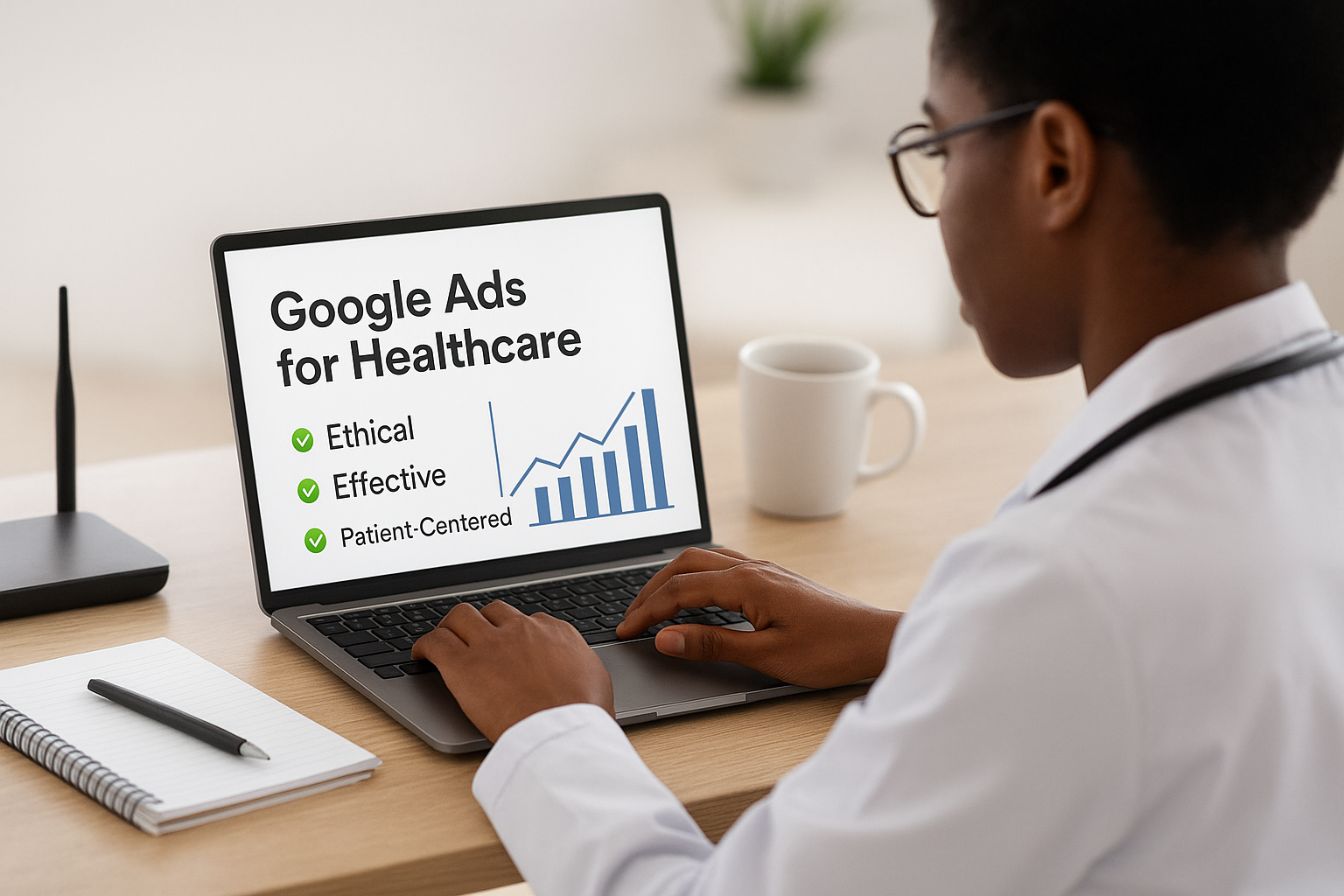In a world where most prospective patients begin their healthcare journey with a search engine query, the opportunity for healthcare providers to connect with new patients via online advertising has never been greater. For practices, clinics and providers, investing in Google Ads (formerly known as AdWords) can be highly effective — but only if done right. In healthcare, advertising isn’t just about clicks and conversions: it’s about trust, compliance, transparency, and genuine patient-care alignment.
This post will walk you through a responsible, ethical and results-driven approach to Google Ads for healthcare: how to plan, launch, optimize and maintain ad campaigns that attract patients — without compromising on ethics or regulatory compliance. Whether you’re a small clinic or a large multi-site provider, the principles hold true.
1. Understanding Google’s Healthcare Advertising Policies
Before launching any campaign, the single most important step is understanding what is allowed — and what isn’t — on Google for healthcare/medical advertising.
1.1 Key policy fundamentals
Google’s “Healthcare & Medicines” advertising policy outlines specific rules for health-related ads. For example:
-
Ads must not include misleading claims such as guaranteed cures or unrealistic outcomes. Google Help+1
-
Prescription drugs, certain medical services and clinical-trial recruitment are heavily regulated (or prohibited) unless specific certifications are in place. Accelerated Digital Media+1
-
Advertisers are responsible not just for the ad copy, but for the landing page, the user pathway and the overall user experience. ihealthspot.com
For example, if you’re running a campaign for a clinic in the U.S. that offers specialized care, you must ensure your ads comply with location-specific rules and your landing pages satisfy regulatory and Google-policy requirements. Google Help+1
1.2 Why compliance matters
The stakes are high. Non-compliance can lead to disapproved ads, account suspensions or broader reputational damage. According to one review, common reasons for healthcare ad disapproval include lack of credentials, inadequate disclaimers, unrealistic claims, and targeting issues. HawkSEM
In other words: getting this step wrong isn’t just a minor oversight — it can jeopardize both your ad account and your practice’s trustworthiness in the eyes of users.
1.3 Certifications & third-party verification
Depending on your region and the nature of your services, you may need to obtain certifications. For example:
-
Online pharmacies or telemedicine providers often need verification such as via LegitScript. Accelerated Digital Media+1
-
Health-insurance advertising or certain medical-device ads may require additional certification or meet extra standards. Google Help
Action point: before you allocate budget, review Google’s policy page for “Healthcare & Medicines” and check the “How does this policy differ by location?” section for your country. Google Help
2. Crafting Patient-Centered Messaging
Once you’ve covered the policy groundwork, the next step is crafting ad copy and messaging that is both ethical and effective.
2.1 Move from features to patient benefits
Instead of leading with “We provide X service,” lead with “You’ll get confident care to address Y need.” Patients respond to benefits: relief, trust, support, expertise. For example:
-
Rather than “We offer knee-replacement surgery,” you might say “Regain mobility with our board-certified orthopedic specialists.”
-
Use language that emphasis the patient’s journey and outcome, not just the service.
2.2 Use compassionate, clear, credible language
Healthcare is a sensitive realm. The tone should be professional yet warm. Avoid fear-based or aggressive language (e.g., “Don’t wait or you’ll be doomed”). Instead, choose phrases like “Schedule a consultation today to explore your options” or “Our trusted team is here to support your recovery.”
Also ensure you include:
-
Credentials (e.g., “board-certified”, “experienced specialists”)
-
Transparent statements (e.g., “Results may vary by individual”)
-
Avoid absolute guarantees (e.g., “100% cure”) — these may trigger policy concerns or user distrust. Evolve Healthcare Marketing+1
2.3 Keywords & search intent alignment
When writing ad copy and selecting keywords, you want to align with what searchers are seeking — not just what you want to promote. Common intent-based keywords in healthcare might include:
-
“best dentist near me”
-
“urgent care open now”
-
“specialist cardiologist consultation”
Avoid overly broad or sensational keywords like “miracle cure” or “fastest healing ever,” as these often flag policy issues or trigger user skepticism.
Tip: Use Geo-modifiers (city, area, clinic name) to capture local intent.
3. Ethical and Effective Targeting
How you target matters as much as what you say — especially in healthcare, where personal data and sensitive attributes come into play.
3.1 Geolocation & demographic targeting
A smart approach is to target users in your local service area (e.g., within X km or specific postal codes). This helps focus budget, improve relevance and reduce wasted clicks.
Additionally:
-
Consider using ad schedules that reflect your clinic hours.
-
For demographic targeting, use minimal and respectful filters. Avoid targeting based on sensitive categories (e.g., health conditions, medical history). Many ad platforms — including Google — restrict “sensitive interest” audiences. Clarity Quest+1
3.2 Avoid sensitive-audience targeting
Google and other ad platforms typically restrict targeting based on health conditions or diseases. For example, you can’t target “people suffering from diabetes” as a bespoke audience without risk. One commenter observed:
“The Health in Personalized Advertising policy restricts you from remarketing… that means if you’ve associated a customer list or website visitors to your campaign Google will not serve ads to those groups.” Reddit
The takeaway: Avoid relying on advertising segments based on sensitive health data. Focus instead on intent (people searching for services) and general location.
3.3 Keywords & negative keywords
Your keyword strategy should reflect user need and specificity. Examples:
-
“pediatric dentist Ibadan”
-
“adult orthodontic clinic Oyo state”
Also build negative keyword lists to filter out irrelevant traffic (e.g., “free”, “DIY”, “home remedy”). This helps maintain relevance and ensures your budget is spent wisely.
One best practice: Set up conversion tracking early (see section later) so you can monitor which keywords drive actual appointments/bookings versus mere clicks.
4. Landing Page Optimization for Trust & Conversion
Your ad is the invitation — but the landing page is the first real interaction your prospective patient has with your practice online. It must inspire trust, deliver clarity, and drive action.
4.1 Trust signals & transparency
On your landing page, include:
-
Practice name and physical address
-
Contact phone number and email
-
High-quality photos of your team/facility
-
Credentials (e.g., doctor licenses, specialist certifications)
-
Testimonials (with permission) or patient reviews
-
Clear privacy policy or disclaimers if you collect patient information
Including such elements improves credibility and reduces friction in the patient’s decision-making.
4.2 Clear call-to-action (CTA)
The goal of your campaign is typically to get the patient to book an appointment or contact you. Ensure the CTA is clear and easy: e.g., “Book your consultation today”, “Call now for a free assessment”, “Fill out the form for a call-back”.
Keep the form simple: name, phone, email, preferred time. The more fields you force, the higher drop-off you’ll likely see.
4.3 Mobile-friendly, fast loading, minimal distractions
Many users searching for healthcare services do so on mobile devices. Ensure your landing page:
-
Loads quickly (aim <3 seconds)
-
Has a responsive design
-
Avoids intrusive pop-ups that can annoy users
-
Have a clear visual hierarchy: headline, benefit statement, trust signals, CTA.
A clean post-click experience keeps users engaged, lowers bounce rate and helps with ad quality.
4.4 Privacy & compliance on the landing page
If you are collecting patient information (name, phone, medical history), you must include a privacy notice. If you are in a region where regulations like Health Insurance Portability and Accountability Act (HIPAA) apply, you need to ensure your data-handling practices are safe and compliant. Generic best-practice: avoid storing sensitive health data in plain-text, encrypt anything stored, restrict access. Penrod
Also ensure you are not making misleading claims (e.g., “Guaranteed cure in 2 weeks”). Use measured language, and honor your ad-copy promises.
5. Tracking, Measurement & Ethical Data Practices
You’ll only know whether your campaigns are working if you measure — but in healthcare advertising, tracking must be done responsibly.
5.1 Defining conversions
Typical conversions for a healthcare ad campaign might include:
-
Appointment booking (via form or phone)
-
Phone call to clinic
-
Contact form submission
-
Live-chat initiation
Set up Google Ads conversion tracking (or offline conversion import) to map these actions back to your campaign/keyword/ad. Doing so helps refine, optimize and scale.
5.2 Data privacy and avoiding sensitive-audience pitfalls
While you track conversions, you must steer clear of practices that might use sensitive health-condition data to profile or target. Google’s policy outlines that targeting or using health-condition based audiences is a restricted area. Clarity Quest+1
Further, if your conversion action captures personally identifying information (PII) or protected health information (PHI), ensure you’re compliant with local rules. This may include obtaining patient consent for remarketing, or avoiding remarketing altogether in certain contexts.
From one blog:
“Redact PHI from all conversion events… Avoid retargeting ads that rely on PHI-related visitor behavior.” Penrod
5.3 Regular review and optimization
Set aside time weekly or monthly to review your campaign dashboards. Key metrics to watch:
-
Conversion rate (appointments/bookings per click)
-
Cost per conversion
-
Click-through rate (CTR)
-
Quality Score (ad relevance, landing page experience, expected click-through)
If a keyword/ad is underperforming (low conversion despite clicks) consider pausing or replacing it. Optimize bids toward high-performing geos, times of day, devices.
Also monitor for policy breakdowns: ads disapproved, landing page flagged, user complaints — these can all reduce account health.
6. Building an Ethical Framework & Trust-First Approach
Beyond the technical execution, ethical advertising demands an overarching mindset: prioritizing the patient’s best interest, transparent communication, and avoiding exploitative tactics.
6.1 Transparency and disclosures
Be clear in your ads and landing pages about what you offer, any terms/conditions, and what the patient should expect. If you’re promoting a special offer or free consultation, clarify what is included/excluded.
Also consider using disclaimers like “Individual results may vary” to avoid over-promise. This builds trust and aligns with good regulatory practice.
6.2 Avoid sensationalism and fear-marketing
While urgency can drive action (e.g., “Limited slots available”), avoid tactics that exploit fear (“If you delay, you will …”). Healthcare consumers are often vulnerable; ethical marketing respects that. Instead use messaging like “Take the first step toward improving your health” rather than “Your condition is spiraling — act now”.
6.3 Respect privacy and user autonomy
Don’t use remarketing or look-alike audiences based on someone’s health-search behavior in a way that feels invasive or manipulative. Instead focus on meeting them at the point of active intent (e.g., searching for “physiotherapist near me”). When asking for personal information, keep it minimal, explain what you’ll do with it, and safeguard it.
A Reddit user in the PPC community put it plainly:
“If you’re just running search ads and aren’t focusing on remarketing, you likely won’t run into the Health in Personalized Advertising policy restrictions.” Reddit
6.4 Aligning with professional ethics of healthcare
Remember that medical professionals have ethics obligations: promoting realistic treatment expectations, avoiding exploitation of patient vulnerability, maintaining patient confidentiality. Your marketing should align with your clinical values. If your ad promises “instant pain relief guaranteed”, that may conflict with clinical realities — and may damage the relationship with patients.
7. Setting Your Campaign Structure & Budget Strategy
With messaging, landing page and ethical guardrails in place, let’s outline how to structure a Google Ads campaign for a healthcare provider.
7.1 Campaign types & networks
Typically for patient-acquisition you’d use:
-
Search campaigns: when users explicitly search for a service (“dermatologist Ibadan”, “urgent care Oyo state”)
-
Location extensions: to show your practice address, encourage map clicks
-
Call-only campaigns: if you want phone calls as the main conversion
-
Responsive search ads: Google’s automated ad formats can help test different headlines/descriptions
Be cautious with display or video networks unless your budget is large and you can ensure strict compliance (display often has more policy restrictions).
7.2 Geo-targeting & ad scheduling
For a single practice in Ibadan, Nigeria, you might target:
-
Radius around Ibadan (e.g., 0–20 km) or specified postal areas
-
Exclude far-flung locations to avoid wasted clicks
-
Schedule ads during your business hours or when staff can answer calls/bookings
This helps ensure that the user clicking the ad finds a responsive team and doesn’t face long waits or confusion.
7.3 Budget allocation & bidding strategy
Start with a moderate daily budget (for example enough to gather ~10–20 clicks/day) and track conversions. Use bidding strategies aligned with conversions (e.g., target CPA or maximize conversions) rather than just clicks.
As you accrue data, gradually ramp up spend on keywords/ad groups that produce the most bookings. Simultaneously pause or refine those with high cost and low conversion.
7.4 Keyword grouping & ad-group structure
Organize your keywords into thematic ad groups (e.g., “Cardiology consultation Ibadan”, “Dental implants Ibadan”, “Pediatric care Ibadan”). For each ad group, tailor the ad copy and landing page to match the service. This improves relevance, Quality Score and ultimately cost-effectiveness.
7.5 Ad extensions & added value
Use ad extensions to enhance your ad:
-
Sitelink extensions (e.g., “Meet our doctors”, “Patient testimonials”, “FAQs”)
-
Callout extensions (e.g., “Board-certified specialists”, “Same-day appointments”, “30-years in Ibadan”)
-
Structured-snippet extensions (e.g., “Services: Orthopedics | Cardiology | Pediatrics”)
These make your ad more informative, increasing click-through and trust.
8. Continuously Optimizing & Scaling Responsibly
Once your campaign is live and running, optimization and scaling are ongoing tasks.
8.1 Analyzing performance and refining
Periodically review:
-
Which keywords are converting vs. which are just driving clicks?
-
What is the cost per acquisition (CPA)? Is it within your acceptable range for a new patient?
-
Is the landing-page bounce rate high? If so, consider landing page tweaks (headlines, imagery, testimonials).
-
Are certain geos, devices or times of day outperforming others? Then shift budget accordingly.
-
Are any ads being disapproved or flagged? Investigate and remedy promptly.
8.2 A/B testing and messaging refinement
Test different variations of headlines, descriptions and calls-to-action. For example:
-
Headline A: “Trusted Ibadan Dermatologist – Book Today”
-
Headline B: “Get Clear Skin with Our Certified Dermatology Team”
Run both, measure performance (CTR, conversion rate) and favor the winner. Over time, iterate. Remember: minor tweaks can lead to major gains.
8.3 Scaling while maintaining compliance
When scaling (increasing budget, broadening targeting, adding services), always revisit the compliance checklist:
-
Are all new services advertised still within Google’s policy?
-
Are you targeting only permissible audiences and keywords?
-
Are landing pages for each new service as optimized and trustworthy as the initial one?
Scaling too fast, without guardrails, can lead to policy violations, inflated costs, or reduced ad effectiveness.
9. Real-World Example: How a Clinic in Ibadan Might Implement
Let’s imagine you’re a multi-specialty clinic located in Ibadan, Oyo State, Nigeria. You want to attract new patients for two services: pediatric care and dermatology.
9.1 Audience & keyword planning
-
Service 1: Pediatric care
-
Keywords: “pediatrician Ibadan”, “children’s clinic Oyo state”, “child health specialist Ibadan”
-
-
Service 2: Dermatology
-
Keywords: “dermatologist Ibadan”, “skin specialist Ibadan”, “acne treatment Oyo state”
You set up two separate campaigns (one for each service) to keep messaging tight.
-
9.2 Ad copy examples
Pediatric campaign ad:
Headline 1: Trusted Pediatric Clinic in Ibadan
Headline 2: Board-Certified Children’s Specialists
Description: Our friendly team provides comprehensive child care from infancy to adolescence. Convenient location, same-day appointments available. Call +234 XXX XXX XXXX.
Dermatology campaign ad:
Headline 1: Skin & Dermatology Specialists Ibadan
Headline 2: Clear Skin, Confident You
Description: Expert dermatologists offering personalized treatment for acne, eczema, skin rejuvenation. Book your consultation today.
9.3 Landing page setup
-
Pediatric page: Practice overview, photo of pediatric team, testimonials from parents, list of services (well-child visits, immunizations, developmental checks), contact form, phone number.
-
Dermatology page: Photo of clinic/derm team, list of services (acne, eczema, skin cancer screening), before-/after (with disclaimers), booking form.
Both pages include: address, map, phone number, privacy policy, short form (name/phone/email).
9.4 Budget & tracking
-
Start with a daily budget of ₦10,000 (or equivalent) split between the two campaigns.
-
Set conversion tracking: form submission or phone call.
-
After 2 weeks or ~200 clicks, review which campaign is performing (cost per booking). Suppose dermatology is converting at ₦2,500 per booking and pediatrics at ₦4,000 per booking.
-
Shift more budget toward dermatology until pediatrics optimizes (adjust ad copy, keyword list, landing page).
9.5 Ethical checks
-
Ensure no claim like “100% acne cure in 7 days” is used — that would violate policy and trust.
-
Avoid targeting “people with skin disease” via sensitive audience layers. Stick to keyword and location targeting.
-
Ensure conversion data does not include PHI (e.g., “child has eczema”) — keep to name/phone/contact.
-
Review ads weekly, ensure no disapproved ads or negative feedback.
10. What to Avoid: Common Pitfalls & Compliance Traps
Knowing what to avoid can save a lot of wasted budget and account headaches.
10.1 Unrealistic claims or guarantees
“Guaranteed pain-free in one session”, “cure your diabetes”, “instant relief with no downtime” — these are red flags. Google requires ads to avoid unsubstantiated or sensational claims. Public Media Solution – Pr Agency+1
10.2 Targeting sensitive categories or using health-condition based audiences
If you start targeting people because they have had a specific condition or are searching for a disease name, you might trigger policy enforcement. Personalized audience lists based on PHI or health-condition segments are especially risky. Clarity Quest+1
10.3 Poor landing-page experience or missing disclosures
If your landing page lacks trust signals, contact info, or includes misleading content, your Quality Score may drop and disapprovals may occur. Also, failing to include privacy policy/disclaimer when capturing patient data is a compliance risk. HawkSEM
10.4 Ignoring policy updates
Healthcare advertising policies can and do change. In fact, Google recently updated its healthcare policy language to clarify which services are covered and how they’ll be monitored. matchnode.com+1
If you ignore updates, you risk being caught out by stricter rules.
10.5 Scaling without quality control
Increasing budget and broadening keywords before you have solid conversion data can lead to wasted spend. Also, the more you scale, the more likely you’ll hit marginal-return issues or regulatory scrutiny.
11. The Long-Term View: Building Patient Relationships & Brand Equity
While acquiring patients is the short-term goal, think about the long-term value — trust, brand reputation, repeat visits and referrals.
11.1 Nurturing patients beyond the first visit
Use your ad-acquired patients as the first step in a long-term relationship:
-
Welcome them with a great experience.
-
Send follow-ups, feedback requests, thank-you notes.
-
Ask for reviews (with consent) — positive reviews feed into future ad credibility and organic search results.
-
Encourage referrals or loyalty programs (if applicable).
11.2 Building brand credibility that amplifies your ads
When your practice becomes known locally for quality care, your ads benefit: higher click-through rates, lower cost per click, better conversion rates. Invest in content marketing, local SEO, social proof — all complement your paid campaigns.
11.3 Combining paid ads with organic strategy
Paid ads should be part of a broader marketing mix. While you run Google Ads for immediate patient-acquisition, invest in:
-
SEO (so your website appears for organic searches)
-
Social media (sharing patient stories, clinic updates)
-
Local listings (Google Business Profile, local directories)
This synergy improves overall performance and reduces dependence on ads alone.
12. Summary Checklist: Ethical & Effective Healthcare Google Ads
Here’s a handy checklist you can use (or print) when planning your campaign:
Pre-launch:
-
Reviewed Google “Healthcare & Medicines” policy and local country variations.
-
Verified any required certifications (e.g., online pharmacy, telemedicine, insurance).
-
Defined clear services, benefits and patient-centered messaging.
-
Selected intent-based keywords with geo-targeting and negative keywords.
-
Created ad copy with professional, compassionate tone; avoided unrealistic claims.
-
Built landing pages that are mobile-friendly, fast-loading, with trust signals, clear CTA, privacy/disclaimer.
-
Set up conversion tracking (form submissions, calls) and defined acceptable cost per acquisition.
-
Ensured data-collection practices avoid PHI misuse and respect user privacy.
Live campaign:
-
Monitor ad approvals and policy compliance daily/weekly.
-
Review performance (CTR, conversions, CPA, bounce rate) weekly.
-
Pause or adjust underperforming keywords/ad groups.
-
Review search-terms report; add negative keywords.
-
Test ad copy variations regularly and iterate winners.
-
Re-allocate budget toward best-performing campaigns/services.
-
Ensure messaging remains aligned with ethical standards and patient-first approach.
Post-conversion & brand building:
-
Follow-up with patients, collect reviews/testimonials (with permission).
-
Gradually scale successful campaigns to adjacent services or geos (while re-applying compliance checks).
-
Harmonize paid campaigns with organic strategy (SEO, content, local listings).
-
Maintain brand reputation: deliver excellent patient experience, maintain transparency and trust.
Conclusion
Advertising via Google Ads offers healthcare providers a significant opportunity to reach prospective patients at precisely the moment they’re searching for help. But unlike many other industries, healthcare has additional layers of responsibility: regulatory compliance, patient privacy, ethics, trust.
By adopting a patient-centered, transparent and policy-informed approach, you can launch Google Ads campaigns that not only bring in new patients but also build your practice’s reputation and long-term growth. Remember: it’s not just about the click — it’s about the care, the experience and the outcome.
If you follow the steps outlined above — understanding policy, crafting the right messaging, targeting smartly, optimizing the user journey, tracking ethically and scaling thoughtfully — you’ll set up a healthcare advertising strategy that works ethically and effectively.
References
-
Google Ads Help – Healthcare & Medicines Advertising Policies. Google Help
-
Google Ads Help – Health Insurance Advertising Policies. Google Help
-
“The Latest Healthcare Advertising Policies on Google Ads and Microsoft Ads (2025)”. Accelerated Digital Media. Accelerated Digital Media
-
“Google Ad’s Healthcare Policy: A Guide for Medical Practices”. iHealthSpot. ihealthspot.com
-
“How to Prevent (and Recover from) Healthcare Ad Restrictions”. HawkSEM. HawkSEM
-
“Guide: Google Ads and HIPAA Compliance”. Penrod. Penrod
-
“Setting Up Healthcare Google Ads for Doctors & Medical Practices”. NinjaPromo. Ninjapromo




